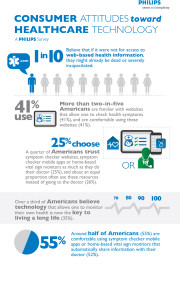 41% of Americans are comfortable using websites that allow them to check health symptoms. Furthermore, 25% of people trust online symptom checkers, mobile apps and home-based vital sign monitors as much as they trust their doctor. In fact, roughly the same proportion uses these tools instead of going to see the doctor, according to a consumer survey from Royal Philips Electronics (Philips).
41% of Americans are comfortable using websites that allow them to check health symptoms. Furthermore, 25% of people trust online symptom checkers, mobile apps and home-based vital sign monitors as much as they trust their doctor. In fact, roughly the same proportion uses these tools instead of going to see the doctor, according to a consumer survey from Royal Philips Electronics (Philips).
The infographic illustrates some of Philip’s top-line findings from this poll, conducted among 1,003 U.S. adults 18 and over in November 2012.
Over one-third of Americans also believe that technology allows them to monitor their health — a key to living a long life, 35% of people said. Strikingly, 1 in 10 people believe that if they weren’t able to access web-based health information, they might “already be dead or severely incapacitated,” according to the survey.
While most Americans are comfortable using symptom checker apps and home-based vital sign monitors that automatically share their personal health data with their doctor, only 29% of those using mobile apps are comfortable sharing that data with physicians.
Health Populi’s Hot Points: The survey demonstrates that health care self-management using information technology tools and mobile apps is now part of America’s do-it-yourself movement that’s emerged in other aspects of daily living, from financial management online to photography development, travel planning and playlist building via iTunes.
The conundrum presented by this survey is that consumers want to share only certain types of data with their physicians. In the Holy Grail of Connected Health, consumers and clinicians co-create health and openly share data — both those generated in the doctor’s (or health system’s) electronic health record and patient-generated data. On the consumer side, there’s collecting of Observations of Daily Living (ODLs, defined by the Robert Wood Johnson Foundation as data collected by people in their own living environment): steps walked, calories consumed, exercise achieved, mood tracking, toileting habits (useful for monitoring GI conditions, for example), among other self-health metrics. Coupled with data in the EHR, such as lab and imaging diagnostic tests, ODLs are very useful integrated with traditional health data for diagnosis and providing patient-centric, personalized care that speaks to the whole individual.
When consumers won’t fully disclose and expose data to their medical home provider, they may be compromising the potential for a richer diagnosis and optimal choices in subsequent treatment paths. What is it about ODLs that people don’t want to share with their physicians, health coaches, and other providers? Now, there’s a survey question with important answers to be learned.




 I'm in amazing company here with other #digitalhealth innovators, thinkers and doers. Thank you to Cristian Cortez Fernandez and Zallud for this recognition; I'm grateful.
I'm in amazing company here with other #digitalhealth innovators, thinkers and doers. Thank you to Cristian Cortez Fernandez and Zallud for this recognition; I'm grateful. Jane was named as a member of the AHIP 2024 Advisory Board, joining some valued colleagues to prepare for the challenges and opportunities facing health plans, systems, and other industry stakeholders.
Jane was named as a member of the AHIP 2024 Advisory Board, joining some valued colleagues to prepare for the challenges and opportunities facing health plans, systems, and other industry stakeholders.  Join Jane at AHIP's annual meeting in Las Vegas: I'll be speaking, moderating a panel, and providing thought leadership on health consumers and bolstering equity, empowerment, and self-care.
Join Jane at AHIP's annual meeting in Las Vegas: I'll be speaking, moderating a panel, and providing thought leadership on health consumers and bolstering equity, empowerment, and self-care.